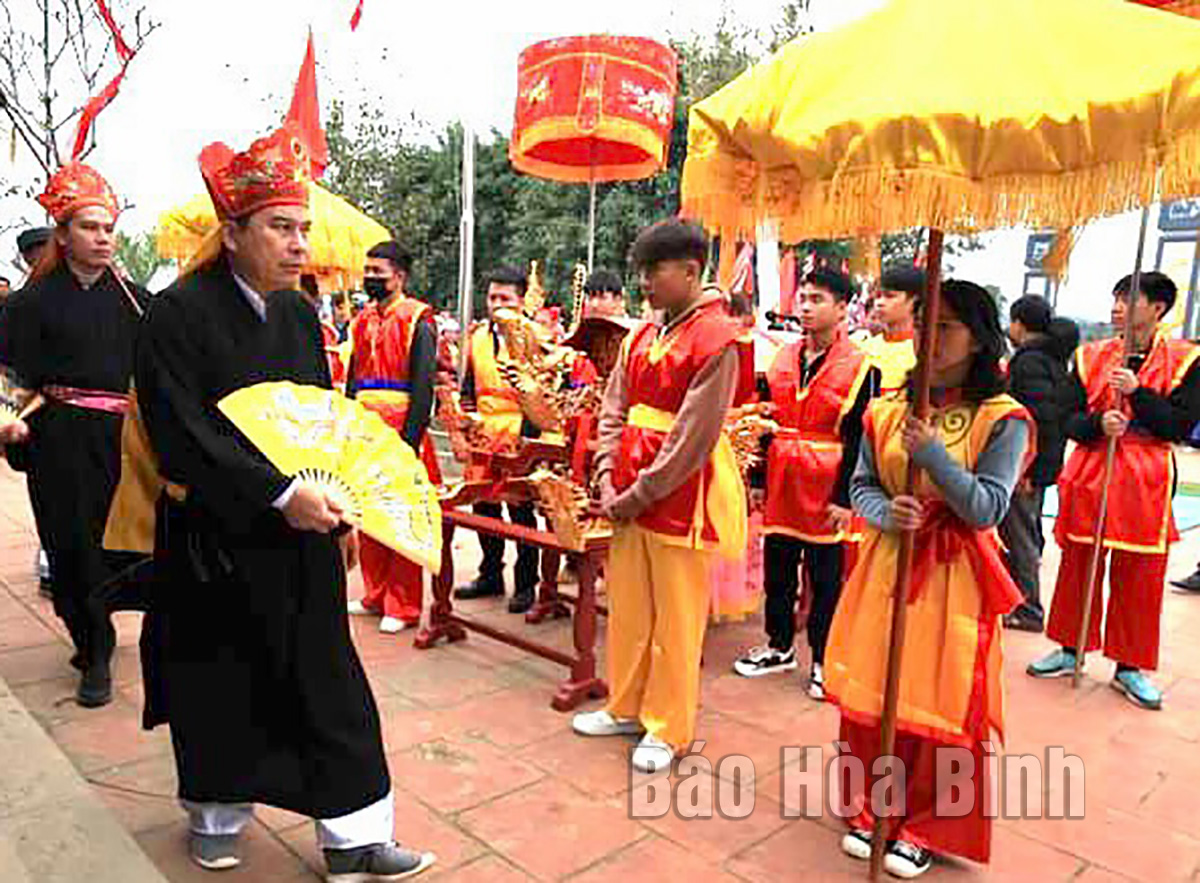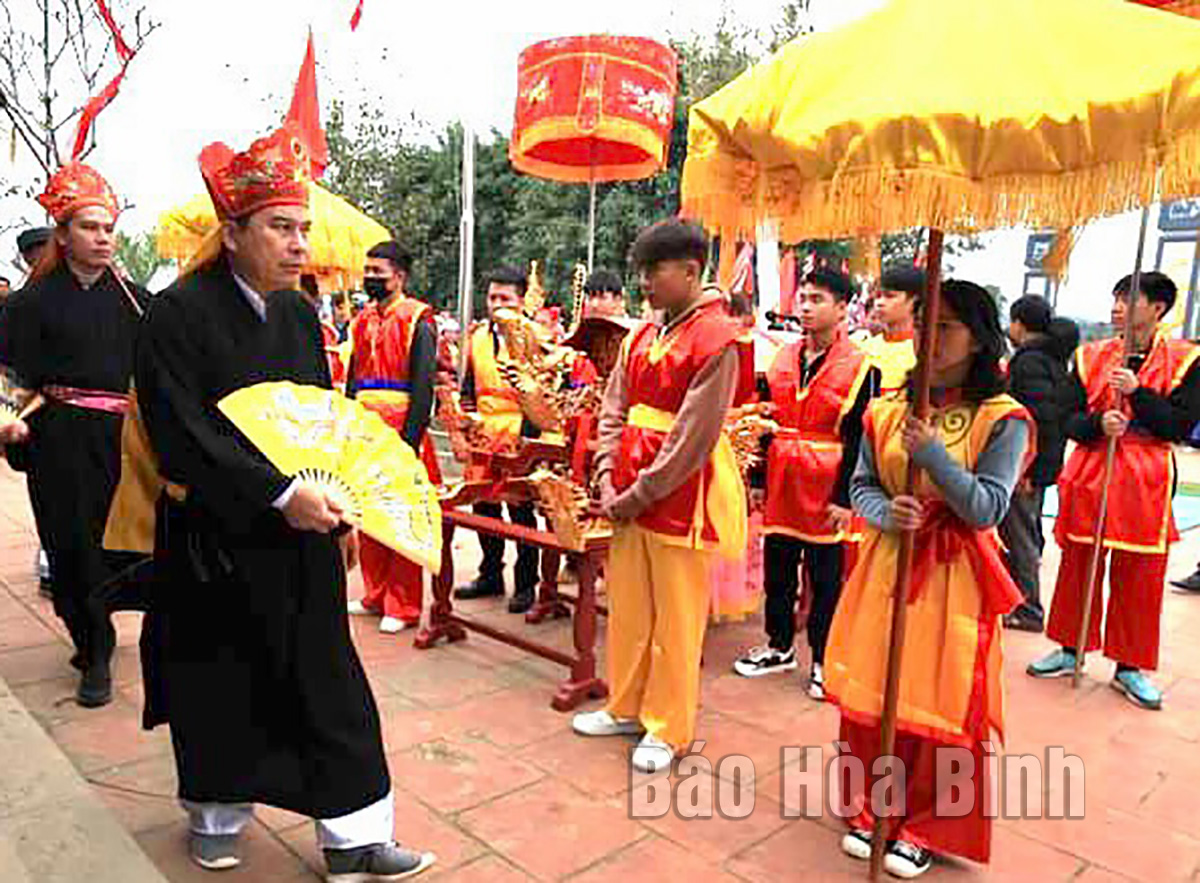
(HBO) – Visiting Muong Vang land of Lac Son district at the beginning of the Lunar New Year, tourists will have a chance to experience festive atmosphere there, thus getting insights into the cultural identity of the locality.
Quoc Mau Hoang Ba (the title of a mother goddess) procession in the Khoi Communal House’s festival.
The festival of Khoi Communal House in An Nghia commune kick-started the spring festival season 2023 in Lac Son district.
The festival took place on January 26-27 (the 5th and 6th day of the first lunar month) with worshipping rituals and festive activities such as art performance, Muong gong performance, and many unique folk games of the Muong ethnic group.
On the occasion, the Khoi communal house was granted the province-level historical cultural relic certificate.
Meanwhile, the festival of Coi communal house in Vu Binh commune was held on January 28-29. Crowds of visitors flocked to this province-level historical cultural relic to join festive activities imbued with traditional cultural imprints of the locality.
Truong Thi Minh Thu, a visitor from Hanoi, said joining the festival helps her understand more about the traditional culture value of the Muong ethnic group in Hoa Binh.
According to statistics, Lac Son has 23 archaeological relics, cultural and historical relics. Khoi communal house in An Nghia commune, Coi communal house in Vu Binh commune, Thuong and Cay Da temples in Vu Ban town, and Bang temple in Ngoc Lau commune are associated with festivals imbued with religious values, becoming attractive destinations for visitors who are interested in culture and beliefs.
Many other festivals were also held in the first lunar month, including the Muong gong festival and the festival of Khenh communal house in Van Son district.
Head of the Culture and Information Office of Lac Son district Nguyen The Hung said besides the unique Muong culture, historical and cultural relics, and spiritual beliefs in the locality have also attracted tourists.
In recent years, the local authorities have paid special attention to upgrading and preserving historical and cultural relics, and places of worship to serve tourism development. Festive activities have contributed to preserving the cultural identity of all ethnic groups in the province./.
With an increasingly vibrant and widespread emulation movement aimed at building cultured residential areas and cultured families, Yen Thuy District has been making steady progress toward improving both the material and spiritual well-being of its people, while fostering a civilized, prosperous, beautiful, and progressive community.
Once lacking recreational spaces and community facilities, Residential Group 2 in Quynh Lam Ward (Hoa Binh City) has recently received attention for the construction of a new, spacious, and fully equipped cultural house. The project followed the model of state support combined with public contributions in both labor and funding.
The "All people unite to build cultural life" movement, which has been effectively integrated with Kim Boi district’s socio-economic development goals, is fostering a lively spirit of emulation across local residential areas, hamlets, villages, public agencies, and enterprises. In addition, through the initiative, traditional cultural values are being preserved and promoted, while community solidarity and mutual support in poverty reduction and economic development are being strengthened.
A working delegation of the Hoa Binh provincial People’s Committee led by its Permanent Vice Chairman Nguyen Van Toan on June 11 inspected the progress of a project to build the Mo Muong Cultural Heritage Conservation Space linked to tourism services in Hop Phong commune, Cao Phong district.
Born and growing in the heroic land of Muong Dong, Dinh Thi Kieu Dung, a resident in Bo town of Kim Boi district, in her childhood was nurtured by the sweet lullabies of her grandmother and mother. These melodies deeply imprinted on her soul, becoming an inseparable part of her love for her ethnic group's culture. For over 20 years, this love for her hometown has driven Dung to research, collect, and pass down the cultural values of the Muong people to future generations.
In the final days of May, the Ethnic Art Troupe of Hoa Binh Province organized performances to serve the people in remote, mountainous, and particularly disadvantaged areas within the province. These were not just ordinary artistic shows, but they were the meaningful journeys aimed at spreading cultural values, enhancing the spiritual life of the people and contributing to the preservation of ethnic minority cultural identities.



